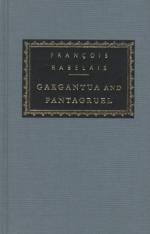For his coat were taken up eighteen hundred ells of blue velvet, dyed in grain, embroidered in its borders with fair gilliflowers, in the middle decked with silver purl, intermixed with plates of gold and store of pearls, hereby showing that in his time he would prove an especial good fellow and singular whipcan.
His girdle was made of three hundred ells and a half of silken serge, half white and half blue, if I mistake it not. His sword was not of Valentia, nor his dagger of Saragossa, for his father could not endure these hidalgos borrachos maranisados como diablos: but he had a fair sword made of wood, and the dagger of boiled leather, as well painted and gilded as any man could wish.
His purse was made of the cod of an elephant, which was given him by Herr Pracontal, proconsul of Lybia.
For his gown were employed nine thousand six hundred ells, wanting two-thirds, of blue velvet, as before, all so diagonally purled, that by true perspective issued thence an unnamed colour, like that you see in the necks of turtle-doves or turkey-cocks, which wonderfully rejoiced the eyes of the beholders. For his bonnet or cap were taken up three hundred, two ells and a quarter of white velvet, and the form thereof was wide and round, of the bigness of his head; for his father said that the caps of the Marrabaise fashion, made like the cover of a pasty, would one time or other bring a mischief on those that wore them. For his plume, he wore a fair great blue feather, plucked from an onocrotal of the country of Hircania the wild, very prettily hanging down over his right ear. For the jewel or brooch which in his cap he carried, he had in a cake of gold, weighing three score and eight marks, a fair piece enamelled, wherein was portrayed a man’s body with two heads, looking towards one another, four arms, four feet, two arses, such as Plato, in Symposio, says was the mystical beginning of man’s nature; and about it was written in Ionic letters, Agame ou zetei ta eautes, or rather, Aner kai gune zugada anthrotos idiaitata, that is, Vir et mulier junctim propriissime homo. To wear about his neck, he had a golden chain, weighing twenty-five thousand and sixty-three marks of gold, the links thereof being made after the manner of great berries, amongst which were set in work green jaspers engraven and cut dragon-like, all environed with beams and sparks, as king Nicepsos of old was wont to wear them: and it reached down to the very bust of the rising of his belly, whereby he reaped great benefit all his life long, as the Greek physicians know well enough. For his gloves were put in work sixteen otters’ skins, and three of the loupgarous, or men-eating wolves, for the bordering of them: and of this stuff were they made, by the appointment of the Cabalists of Sanlouand. As for the rings which his father would have him to wear, to renew the ancient mark of nobility, he had on the forefinger of his left hand a carbuncle




